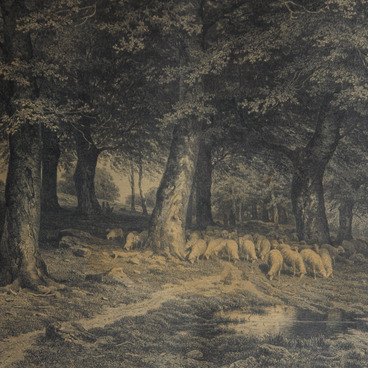Porcelain cup in the form of a bowl with polychrome overglaze painting in “chinoiserie” style. It depicts a lady sitting at a table with a fan and two children playing with a dog (similar to a dragon); a landscape with a blue mountain and flowers of golden peonies, small butterflies and birds. Painting with fine gold cuts.
Chinoiserie is accompanied by the fashion for tea and the dishes necessary for tea drinking appear. From miniature bowls, tea was sipped in small sips, it did not have time to cool down and its taste was fully revealed. A small bowl emphasizes the value of tea as an elite product. There were two types of tea on the Russian market: caravan (Kyakhtinsky), it was transported by land routes along the Great Tea Way; and Cantonese — it was exported from China by sea and through Europe to Russia.
The style of “chinoiserie” (chinoiserie means “Chinese” in French) influenced the art of Europe for almost two centuries — from the end of the XVII to the middle of the XIX century. It originated thanks to Chinese porcelain, actively imported by ships of the East India Company and caravans of the Great Silk Road. In Russia, porcelain objects in this style appeared in the second half of the XVIII century, sometimes as compilations of works of European porcelain productions. Russian artists have merged traditional genres of Chinese painting into a single whole. European and Russian porcelain in the “Chinese style” is not an exact reproduction of the original tradition. Porcelain works in the “chinoiserie” style were created for the European viewer with his worldview and aesthetic preferences.
The cup was made in the 1840s — 1855 at the Imperial Porcelain Factory. In those years, the technical component of production changed at the plant. The instruction given by Catherine II about the use of only domestic clay in production was violated for the first time, French (Limoges) clay was allowed to be used. With the beginning of the use of Limoges clay, the products received almost complete similarity with English and French porcelain in whiteness, fineness and strength. In addition to gilding, platinum was also used in the design of products. The decoration of the products of this period was rich and varied.
Chinoiserie is accompanied by the fashion for tea and the dishes necessary for tea drinking appear. From miniature bowls, tea was sipped in small sips, it did not have time to cool down and its taste was fully revealed. A small bowl emphasizes the value of tea as an elite product. There were two types of tea on the Russian market: caravan (Kyakhtinsky), it was transported by land routes along the Great Tea Way; and Cantonese — it was exported from China by sea and through Europe to Russia.
The style of “chinoiserie” (chinoiserie means “Chinese” in French) influenced the art of Europe for almost two centuries — from the end of the XVII to the middle of the XIX century. It originated thanks to Chinese porcelain, actively imported by ships of the East India Company and caravans of the Great Silk Road. In Russia, porcelain objects in this style appeared in the second half of the XVIII century, sometimes as compilations of works of European porcelain productions. Russian artists have merged traditional genres of Chinese painting into a single whole. European and Russian porcelain in the “Chinese style” is not an exact reproduction of the original tradition. Porcelain works in the “chinoiserie” style were created for the European viewer with his worldview and aesthetic preferences.
The cup was made in the 1840s — 1855 at the Imperial Porcelain Factory. In those years, the technical component of production changed at the plant. The instruction given by Catherine II about the use of only domestic clay in production was violated for the first time, French (Limoges) clay was allowed to be used. With the beginning of the use of Limoges clay, the products received almost complete similarity with English and French porcelain in whiteness, fineness and strength. In addition to gilding, platinum was also used in the design of products. The decoration of the products of this period was rich and varied.


